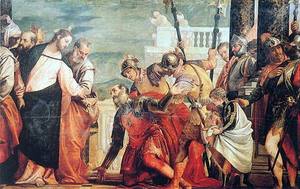Domine, non sum dignus

Monday of the First Week of Advent
Isaiah 2:1–5
Psalm 121:1–2, 3–4ab, 4cd–5, 6–7, 8–9
Matthew 8:5–11
Saints in Advent
We celebrate the Holy Mysteries today in the company of two saints, both of them lights from the East: Saint Barbara, Virgin and Martyr, and Saint John Damascene, Priest and Doctor of the Church. Saint Barbara, according to the legend, was enclosed in a tower (some accounts say it was a bathhouse) by her pagan father. There were two windows in this improvised prison cell.
Three Windows
Taking advantage of her father’s temporary absence, Barbara instructed the servants to make a third window in honour of the Most Holy Trinity. The light poured into Barbara’s cell from three windows; her soul, meanwhile, was flooded by what Saint Benedict calls “the deifying light” of the Three Divine Persons. Thus was Saint Barbara found, as today’s Collect puts it, “vigilant in prayer and joyful in singing His praises,” at the hour of her martyrdom.
God is Light
In this, Saint Barbara speaks to all who feel hemmed in and imprisoned by the circumstances of life. To all who feel shut in and imprisoned, to all who live behind walls, Saint Barbara says, “Lift your eyes to the light of the Most Holy Trinity. Let the glorious radiance of the Three Divine Persons shine in your solitude.” Her message is that of Saint Paul who says, “Mind the things that are above, not the things that are upon the earth. For you are dead; and your life is hid with Christ in God. When Christ shall appear, who is your life, then you shall appear with Him in glory” (Col 3:2–4). Her message is that of the Apostle John: “God is light, and in Him there is no darkness” (1 Jn 1:5).
At the Door
Captivity became for Saint Barbara a time of “eager anticipation” for the advent of Christ her Bridegroom. Today’s Collect would have us await the advent of Christ, not in idleness and revery, but with an active engagement of self, in such wise that waiting becomes seeking. Then when Christ knocks at the door, He will find us vigilant in prayer and joyful in singing His praises. “Behold,” He says, “I stand at the gate, and knock. If any man shall hear my voice, and open to me the door, I will come in to him, and will sup with him, and he with me” (Ap 3:20).
Show us Thy Face
The Alleluia Verse had us say, “Come to deliver us, O Lord our God: show us Thy face, and we shall be saved” (Ps 79:3). Christ Jesus is the Human Face of God. Saint John Damascene’s defense of the place of icons in the Church rests on this truth. To Philip asking to see the Father, Our Lord replied, “He that seeth me seeth the Father also” (Jn 14:9). The Face of Christ is the Face of God; that adorable Face, depicted in icons by means of line and colour, is worthy of our worship.
The Light of His Countenance
In the light of the Face of Christ there is healing for our infirmities and wholeness for our brokenness. All that we are is exposed to all that He is in the mystery of the Most Holy Eucharist. “Thou hast set our iniquities before Thy eyes: our life in the light of Thy countenance” (Ps 89:8). The Eucharist is the presence of Christ, “the icon of the invisible God” (Col 1:15); the Eucharist is the Human Face of God turned toward us, coming toward us, visiting us, entering under our roof.
Lord, I Am Not Worthy
How fitting that in every Mass, before Holy Communion, we should repeat the words of the centurion in today’s Gospel: “Lord, I am not worthy that Thou shouldst enter under my roof: but only say the word, and my servant — my soul — shall be healed” (Mt 8:8). Every place visited by Christ is illumined by the radiance of His Face and, in that radiance there is healing and the forgiveness of sins.
Three Times
Personally, I think it a great pity that the words of the centurion are no longer said thrice before Holy Communion. This is one of the more egregious mistakes of the reformed Mass, one example of the kind of thing that contributes to the over–all impression of minimalism. The three–fold repetition of the centurion’s prayer, reinforced by the striking of one’s breast each time, demonstrates a marvelous liturgical pedagogy and engages the whole person in preparing to receive the Body and Blood of Christ.
In Thy House Today
I ask Saint Barbara, Saint John Damascene, and the Centurion of the Gospel to intercede for us today, that we may worthily approach the Eucharistic Face of Christ in the Holy Mysteries. We are not worthy to welcome Him under our roof, but to each of us He says what once He said to Zacchaeus: “This day I must abide in thy house” (Lk 19:5).
